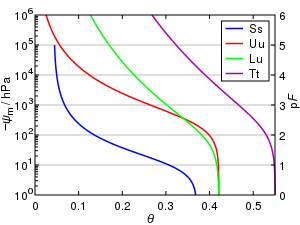Water retention curve

Water retention curve is the relationship between the water content, θ, and the soil water potential, ψ. The soil moisture curve is characteristic for different types of soil, and is also called the soil moisture characteristic.
It is used to predict the soil water storage, water supply to the plants (field capacity) and soil aggregate stability. Due to the hysteretic effect of water filling and draining the pores, different wetting and drying curves may be distinguished.
The general features of a water retention curve can be seen in the figure, in which the volume water content, θ, is plotted against the matric potential, . At potentials close to zero, a soil is close to saturation, and water is held in the soil primarily by capillary forces. As θ decreases, binding of the water becomes stronger, and at small potentials (more negative, approaching wilting point) water is strongly bound in the smallest of pores, at contact points between grains and as films bound by adsorptive forces around particles.
Sandy soils will involve mainly capillary binding, and will therefore release most of the water at higher potentials, while clayey soils, with adhesive and osmotic binding, will release water at lower (more negative) potentials. At any given potential, peaty soils will usually display much higher moisture contents than clayey soils, which would be expected to hold more water than sandy soils. The water holding capacity of any soil is due to the porosity and the nature of the bonding in the soil.
Curve models
The shape of water retention curves can be characterized by several models, one of them known as the Van Genuchten model:[1]
where
- is the water retention curve [L3L−3];
- is suction pressure ([L] or cm of water);
- saturated water content [L3L−3];
- residual water content [L3L−3];
- is related to the inverse of the air entry suction, ([L−1], or cm−1); and,
- is a measure of the pore-size distribution, (dimensionless).
Based on this parametrization a prediction model for the shape of the unsaturated hydraulic conductivity - saturation - pressure relationship was developed.[2]
History
In 1907, Edgar Buckingham created the first water retention curve.[2] It was measured and made for six soils varying in texture from sand to clay. The data came from experiments made on soil columns 48 inch tall, where a constant water level maintained about 2 inches above the bottom through periodic addition of water from a side tube. The upper ends were closed to prevent evaporation.
Method
The Van Genuchten parameters ( and ) can be determined through field or laboratory testing. One of the methods is the instantaneous profile method,[3] where water content (or effective saturation ) are determined for a series of suction pressure measurements . Due to the non-linearity of the equation, numerical techniques such as the non-linear least-squares method can be used to solve the van Genuchten parameters.[4][5] The accuracy of the estimated parameters will depend on the quality of the acquired dataset ( and ). Structural overestimation or underestimation can occur when water retention curves are fitted with non-linear least squares. In these cases, the representation of water retention curves can be improved in terms of accuracy and uncertainty by applying Gaussian Process regression to the residuals obtained after non-linear least-squares. This is mostly due to the correlation between the data points, which is accounted for with Gaussian Process regression through the kernel function.[6]
See also
References
- ^ van Genuchten, M.Th. (1980). "A closed-form equation for predicting the hydraulic conductivity of unsaturated soils". Soil Science Society of America Journal. 44 (5): 892–898. Bibcode:1980SSASJ..44..892V. doi:10.2136/sssaj1980.03615995004400050002x. hdl:10338.dmlcz/141699.
- ^ a b Buckingham, Edgar (1907), Studies on the movement of soil moisture, Bureau of Soils, Bulletin, vol. 38, Washington, D.C.: U.S. Department of Agriculture
- ^ Watson, K.K.. (1966). "An instantaneous profile method for determining the hydraulic conductivity of unsaturated porous materials". Water Resources Research. 2 (4): 709–715. Bibcode:1966WRR.....2..709W. doi:10.1029/WR002i004p00709.
- ^ Seki, K. (2007). "SWRC fit - a nonlinear fitting program with a water retention curve for soils having unimodal and bimodal pore structure" (PDF). Hydrology and Earth System Sciences Discussions. 4 (1): 407–437. Bibcode:2007HESSD...4..407S. doi:10.5194/hessd-4-407-2007.
- ^ Chou, T.K. (2016). "A free GUI application for solving the van Genuchten parameters using non-linear least-squares minimization and curve-fitting" (PDF). www.cmcsjc.com. January: 1–5. Archived from the original (PDF) on 2016-03-04.
- ^ Yousef, B. (June 2019). Gaussian Process Regression Models for Predicting Water Retention Curves - Application of Machine Learning Techniques for Modelling Uncertainty in Hydraulic Curves. Retrieved from the Delft University of Technology repository.
- Brady, N.C. (1999). The Nature and Properties of Soils (12th ed.). Upper Saddle River, NJ: Prentice-Hall. pp. 183–9. ISBN 0-13-852444-0.
External links
- UNSODA Model database of unsaturated soil hydraulic properties (UNSODA viewer)
- SWRC Fit fit soil hydraulic models to soil water retention data


![{\displaystyle \theta (\psi )=\theta _{r}+{\frac {\theta _{s}-\theta _{r}}{\left[1+(\alpha |\psi |)^{n}\right]^{1-1/n}}}}](https://wikimedia.org/api/rest_v1/media/math/render/svg/215d9c2dda9d084a016a5a86296300f917923472)










